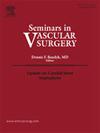Management and outcomes of thoracic dissection in older adults
IF 2.4
3区 医学
Q1 PERIPHERAL VASCULAR DISEASE
引用次数: 0
Abstract
Aortic dissection carries significant morbidity and mortality, particularly with involvement of the ascending aorta. The estimated prevalence of aortic dissection in the general population is between 2.0 and 3.5 per 100,000 people; the risk of which increases with age and underlying risk factors, such as hypertension, long-term tobacco use, and genetic aortopathy. The older adult population continues to increase exponentially, with people older than 65 years accounting for nearly 20% of the total population. The unique challenges associated with treating older patients include consideration of reduced physiologic reserve, increased comorbidity profiles, and clinical frailty. Although surgical repair and endovascular repair have notable survival benefits in the setting of acute aortic dissection, older patients are more frequently offered medical management alone. More recently, the proliferation and evolution of endovascular therapies has offered novel and minimally invasive treatment options for older patients with acute and chronic post-dissection thoracoabdominal aortic aneurysms. In this article, the underlying risk factors, pathophysiology, and clinical decision making for patients with acute dissection are described. In addition, the considerations for treatment of both acute and chronic aortic dissection in this unique patient population are outlined.
老年人胸夹层的处理和结果
主动脉夹层有很高的发病率和死亡率,尤其是累及升主动脉时。一般人群中主动脉夹层的患病率估计在每10万人中有2.0到3.5人;其风险随着年龄和潜在风险因素(如高血压、长期吸烟和遗传性主动脉病变)的增加而增加。老年人口继续呈指数增长,65岁以上的人口占总人口的近20%。与治疗老年患者相关的独特挑战包括考虑生理储备减少、合并症增加和临床虚弱。尽管手术修复和血管内修复对急性主动脉夹层患者的生存有显著的好处,但老年患者更常单独接受药物治疗。近年来,血管内治疗的发展为老年急性和慢性胸腹主动脉瘤夹层后患者提供了新颖的微创治疗选择。在这篇文章中,潜在的危险因素,病理生理和临床决策的患者急性夹层描述。此外,考虑到治疗急性和慢性主动脉夹层在这一独特的患者群体概述。
本文章由计算机程序翻译,如有差异,请以英文原文为准。
求助全文
约1分钟内获得全文
求助全文
来源期刊
CiteScore
3.50
自引率
4.00%
发文量
54
审稿时长
50 days
期刊介绍:
Each issue of Seminars in Vascular Surgery examines the latest thinking on a particular clinical problem and features new diagnostic and operative techniques. The journal allows practitioners to expand their capabilities and to keep pace with the most rapidly evolving areas of surgery.

 求助内容:
求助内容: 应助结果提醒方式:
应助结果提醒方式:


